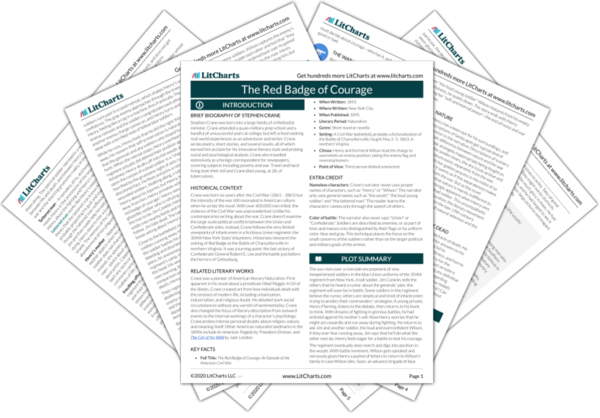Welcome to the LitCharts study guide on Stephen Crane's The Red Badge of Courage. Created by the original team behind SparkNotes, LitCharts are the world's best literature guides.
The Red Badge of Courage: Introduction
The Red Badge of Courage: Plot Summary
The Red Badge of Courage: Detailed Summary & Analysis
The Red Badge of Courage: Themes
The Red Badge of Courage: Quotes
The Red Badge of Courage: Characters
The Red Badge of Courage: Symbols
The Red Badge of Courage: Literary Devices
The Red Badge of Courage: Theme Wheel
Brief Biography of Stephen Crane

Historical Context of The Red Badge of Courage
Other Books Related to The Red Badge of Courage
- Full Title: The Red Badge of Courage: An Episode of the American Civil War
- When Written: 1893
- Where Written: New York City
- When Published: 1895
- Literary Period: Naturalism
- Genre: Short novel or novella
- Setting: A Civil War battlefield, probably a fictionalization of the Battle of Chancellorsville, fought May 2–5, 1863, in northern Virginia
- Climax: Henry and his friend Wilson lead the charge to overwhelm an enemy position, taking the enemy flag and several prisoners.
- Point of View: Third-person limited omniscient
Extra Credit for The Red Badge of Courage
Nameless characters: Crane's narrator never uses proper names of characters, such as "Henry" or "Wilson." The narrator only uses general names such as "the youth," "the loud young soldier," and "the tattered man." The reader learns the characters' names only through the speech of others.
Color of battle: The narrator also never says "Union" or "Confederate." Soldiers are described as enemies, or as part of lines and masses only distinguished by their flags or by uniform color: blue and gray. This technique places the focus on the small concerns of the soldiers rather than on the larger political and military goals of the armies.







